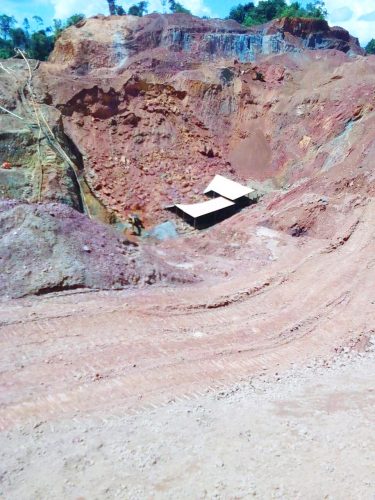As part of its response to the Inter-American Commission on Human Rights (IACHR) resolution issued on July 21 concerning the Chinese Landing Village, the Government of Guyana has announced its decision to temporarily end all mining there as it engages the Toshao and council on the way forward.
This announcement was contained in a release yesterday from the Ministry of Parliamentary Affairs and Governance (MPAG). This, it explained, was in response to the claims contained in the IACHR resolution where it was mentioned that residents of the community did not feel safe passing through mining concessions to conduct their lawful activities. In fact this very concern was stated in a letter to the Minister of Parliamentary Affairs and Governance, Gail Teixeira dated July 29, in which Chinese Landing Village Toshao, Orin Fernandes, stated that steps which require immediate attention included “mining activity must stop.” The release also noted that the decision to halt mining was as a direct result of the ongoing communication between the Government of Guyana through the Minister of Parliamentary Affairs and Governance and the Chinese Landing Village Council through Toshao Fernandes.

The release also took care to highlight that there has been constant communication between MPAG and Toshao Fernandes. An initial request for the planned fact-finding mission to be accommodated was sent to Toshao Fernandes on July 28. A response was received dated July 29 in which the Toshao explained that “while we appreciate your quick reaction and proposal…the village council requires slightly more time to confer with the village on the appropriate measures.” He also indicated in his correspondence that he was not clear about the purpose of the fact-finding mission.
The Government of Guyana then dispatched another correspondence on July 31, 2023 to the Toshao, responding to all questions and concerns and making clear the government’s approach. The letter reiterated that the fact-finding mission was being implanted to effectively implement requests from the IACHR for the Government of Guyana to “report on the actions taken to investigate the events that led up to the adoption of [the] precautionary measure, so as to prevent such events from happening again.” Fernandes was reminded that the outstanding issues identified by IACHR as prompted by the community’s May 22 submission were only seen for the first time by government when it received the IACHR resolution, and as such, those claims would need to be investigated as they include further allegations about health, environment pollution and outstanding investigations with regards to harassment, intimidation and personal integrity.
Deploy
In that very letter, the government said that it would comply with the request of the village council to stop all mining in the village, and to this end, planned to deploy a team from the Guyana Police Force and the Guyana Geology and Mines Commission “to put this decision into effect and to ensure that there is a peaceful cessation to all mining.”
A request was also made for the fact-finding mission to be shifted to August 5-6, to allow for the measures to be properly implemented.
According to the release, the government is appreciative of the continued communication with the Toshao, “even in the face of inevitable differences.” It pointed out that in the space of only five days there have been a total of four correspondences between the parties, and interprets this as the Village Council’s willingness to collaborate with government in the best interest of the community of Chinese Landing.
“The Government of Guyana welcomes the efforts made by the Chinese Landing Village Council and commits to continue working directly with the beneficiaries (the people of Chinese Landing) and their elected representatives (Toshao Orin Fernandes and the Village Council).”
However, the release then shifted gears and turned its attention to a statement put out by the Amerindian Peoples Association (APA) concerning the Chinese Landing issue. It described the APA’s remarks on this issue as “most disingenuous and tantamount to fueling rivalry and creating an unnecessarily divisive environment.” It quoted part of an APA statement which was published in Wednesday’s edition of Stabroek News which states, “MPAG’s announced plan suggests that it, at best, does not understand the IACHR’s recommendations, or that, at worst, it is deliberately attempting to undermine the village’s rights.” As MPAG sees it, this quotation is a clear indication that the APA does not respect the process laid out by the IACHR and does not wish the matters affecting the Chinese landing community to be resolved by the government and the community. Further, it challenged the association “to play a more constructive role in the implementation of these measures.”
And the ministry’s flogging of APA didn’t end there. It proceeded to call on the APA “in the interest of full disclosure and transparency,” to share with its constituents the records of the funds it has been receiving to implement numerous projects. The release informed that simple research would reveal that from 2019 to 2026 APA has been allocated a total of US$5,151,387 (in excess of $1.03 billion) by the Land Tenure Facility (based in Stockholm, Sweden). And according to the Land Tenure Facility this project is supposed to “support the 70,000-strong indigenous population – roughly 10% of the nation – in work to protect their cultural and practical links to the land, by securing legal ownership” (https://thetenurefacility.org/country/guyana/)
Numerous
It added that of the numerous funding sources, this is the only donor which has been directly transparent about the project funds which are being made available to the APA.
The release delved into further detail by pointing out that the stakeholders listed under this project included, “the National Toshaos Council, and the Ministry of Indigenous Peoples Affairs.” However, MPAG says that these entities have no records of any engagements with the APA with regards to the project outline. It also notes that in Phase 2 (2023-2026) “Securing and Enhancing Indigenous Land Tenure in Guyana” of this project, valued at the sum of US$3,001,887 ($600 million), the Ministry of Amerindian Affairs and National Toshaos Council have not been listed as stakeholders; “a clear indication of the APA’s unwillingness to work with Government and the National Toshaos Council. It should also be noted that Amerindian Land Titling is a process which engages the Amerindian communities and the Government of Guyana in accordance with the Amerindian Act– the APA has no authority to allocate titles to Amerindian Communities.”
MPAG also highlighted that in contrast to funds awarded to the APA, “The PPP/C Government of Guyana receives absolutely zero financial support from any international or regional civil society body, Trust Fund, etc., in its consistent work to advance land titling, extensions, and demarcation of Amerindian lands.” It underscored that government has allocated over $560 million in 2022 and over $500 million in 2023 towards land titling only, not inclusive of the multibillion-dollar budgets geared towards Amerindian Development, nor the carbon credit financing for Amerindian villages as part of the carbon credits partnerships.
The release also accused the APA of making representation to the independent ART-TREES, and failing, to have Guyana’s ART-TREES carbon credits suspended. These resources, it avers, are being used to directly improve the social and economic development of Amerindian communities. As such this year, the first payment of $4.7 billion (US$22 million) is being disbursed to 241 Indigenous communities.
The way MPAG sees it, the APA’s request for the suspension of the process would have denied much needed resources from the Amerindian communities, “a grave injustice to the indigenous peoples of Guyana.”
It added that the ART-TREES independent grievance process had verified that the APA made false claims that they had not been appropriately consulted, and that the complaint had been made without the knowledge or support of any Amerindian communities in Guyana, and even without the knowledge of any of their elected representatives who form the National Toshaos Council.
“It is unfortunate that the APA continues to misrepresent the needs of Amerindian communities in an effort to consistently conflagrate situations which may invite more donor attention, and consequently lead to accessing more funding.”
The release assured that the Government of Guyana is committed to working with the people of Chinese Landing, who are the “real beneficiaries,” to ensure that the identified issues can be adequately resolved. “We trust that this decision to implement a cessation on all mining is welcomed by the people of Chinese Landing as it was part and parcel of their primary requests.”
Government also stated that it welcomes the open communication approach by Toshao Fernandes and the Chinese Landing Village Council, and looks forward to realizing the important fact-finding mission as soon as practically possible, the release added.





